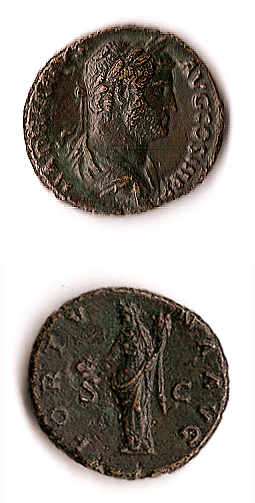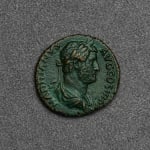Bronze Coin (Assarius) of Emperor Hadrian, 134 CE - 138 CE
Bronze
10.1g
LC.007
Further images
Obverse | Lateral portrait of Emperor Hadrian wearing a laurel wreath Inscription | HADRIANVS AVG COS III P P Reverse | Fortuna, the goddess of fate with a cornucopia and...
Obverse | Lateral portrait of Emperor Hadrian wearing a laurel wreath
Inscription | HADRIANVS AVG COS III P P
Reverse | Fortuna, the goddess of fate with a cornucopia and a patera
Inscription | FORTVNA AVG S C
Condition: Dark green-brown patina, good-very fine.
Publius Aelius Hadrianus, known by his nom de guerre Hadrian, served as Roman Emperor from 117 to 138 CE, during which time the Roman Empire reached the height of its power and influence. The third of the Five Good Emperors, Hadrian's reign was characterized by a comparatively humanitarian and conservative approach to government. His reign was marked by a period of relative peace and stability known as the Pax Romana. In addition to his reputation as a skilled ruler, Hadrian was also known for his intellectual and artistic pursuits. With a deep appreciation for Greek culture, Hadrian famously grew a beard, following the Ancient Greek tradition of a full beard as a symbol of masculinity. As a result, Hadrian is often depicted with a full beard, as in the portrait on the obverse of this coin. The inscription on the obverse reads "HADRIANVS AVGustus CONSul III(Tertius) Pater Patriae," which translates to "Emperor Hadrian, Third Consul, Father of the Nation," dating the coin to 119 CE, when Hadrian held the title of Third Consul. The reverse depicts Fortuna, the Roman mythological goddess of fate and fortune, holding a cornucopia and a patera, a drinking cup. The inscription reads "FORTVNA AVGusti Senatus Consultum," the name of the goddess Fortuna, and the fact that the coin was issued by decree of the Senate.
This is a striking and attractive ancient coin. Fortuna was the Roman Goddess of Fortune, while the cornucopia she is holding symbolises prosperity. It is also known as the Horn of Plenty. Publius Aelius Hadrianus, better known as Hadrian, was born in Spain in 76 AD and died in 138 AD. He ruled the Roman Empire from 117 to 138, during which time the Empire reached its apotheosis. Being the third of the so called Five Good Emperors, his rule was characterised by comparatively humanitarianism and conservatism. Following a political career of some distinction - he served as prefect, legate, consul, tribune and senator - it was his expedition to Parthia with Trajan led to his greatest success; Trajan became seriously ill and died on the way back to Rome, naming Hadrian as successor. Hadrian purged the senate of opposition upon his return to Rome, and set about a somewhat conservative reign that involved strengthening the empire's boundaries and the surrender of indefensible areas (i.e. Mesopotamia). He was known more for rule by threat and strength than active military conquest. Personally, he was well educated and fond of the great Greek writers and philosophers, and was even appointed Archon in Athens. He was a great patron of the arts, including landscaping and architecture: under his reign the Pantheon was rebuilt, as well as many libraries, aqueducts, libraries and theatres. He was also a keen poet, an Epicurean philosopher and a huntsman, commissioning various reliefs showing him killing bears, lions etc. He is also notable for introducing the socially-acceptable beard - all other emperors before him had been clean shaven. The great love of his life was a boy named Antinous, which may explain the lack of natural heirs to Hadrian's lineage. Antinous drowned in the Nile aged about 19; the mourning Hadrian had him deified.
Inscription | HADRIANVS AVG COS III P P
Reverse | Fortuna, the goddess of fate with a cornucopia and a patera
Inscription | FORTVNA AVG S C
Condition: Dark green-brown patina, good-very fine.
Publius Aelius Hadrianus, known by his nom de guerre Hadrian, served as Roman Emperor from 117 to 138 CE, during which time the Roman Empire reached the height of its power and influence. The third of the Five Good Emperors, Hadrian's reign was characterized by a comparatively humanitarian and conservative approach to government. His reign was marked by a period of relative peace and stability known as the Pax Romana. In addition to his reputation as a skilled ruler, Hadrian was also known for his intellectual and artistic pursuits. With a deep appreciation for Greek culture, Hadrian famously grew a beard, following the Ancient Greek tradition of a full beard as a symbol of masculinity. As a result, Hadrian is often depicted with a full beard, as in the portrait on the obverse of this coin. The inscription on the obverse reads "HADRIANVS AVGustus CONSul III(Tertius) Pater Patriae," which translates to "Emperor Hadrian, Third Consul, Father of the Nation," dating the coin to 119 CE, when Hadrian held the title of Third Consul. The reverse depicts Fortuna, the Roman mythological goddess of fate and fortune, holding a cornucopia and a patera, a drinking cup. The inscription reads "FORTVNA AVGusti Senatus Consultum," the name of the goddess Fortuna, and the fact that the coin was issued by decree of the Senate.
This is a striking and attractive ancient coin. Fortuna was the Roman Goddess of Fortune, while the cornucopia she is holding symbolises prosperity. It is also known as the Horn of Plenty. Publius Aelius Hadrianus, better known as Hadrian, was born in Spain in 76 AD and died in 138 AD. He ruled the Roman Empire from 117 to 138, during which time the Empire reached its apotheosis. Being the third of the so called Five Good Emperors, his rule was characterised by comparatively humanitarianism and conservatism. Following a political career of some distinction - he served as prefect, legate, consul, tribune and senator - it was his expedition to Parthia with Trajan led to his greatest success; Trajan became seriously ill and died on the way back to Rome, naming Hadrian as successor. Hadrian purged the senate of opposition upon his return to Rome, and set about a somewhat conservative reign that involved strengthening the empire's boundaries and the surrender of indefensible areas (i.e. Mesopotamia). He was known more for rule by threat and strength than active military conquest. Personally, he was well educated and fond of the great Greek writers and philosophers, and was even appointed Archon in Athens. He was a great patron of the arts, including landscaping and architecture: under his reign the Pantheon was rebuilt, as well as many libraries, aqueducts, libraries and theatres. He was also a keen poet, an Epicurean philosopher and a huntsman, commissioning various reliefs showing him killing bears, lions etc. He is also notable for introducing the socially-acceptable beard - all other emperors before him had been clean shaven. The great love of his life was a boy named Antinous, which may explain the lack of natural heirs to Hadrian's lineage. Antinous drowned in the Nile aged about 19; the mourning Hadrian had him deified.





